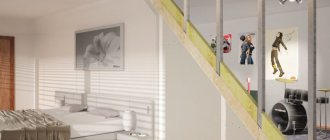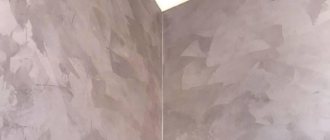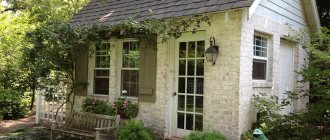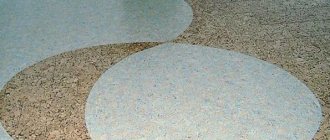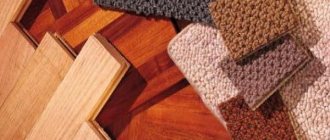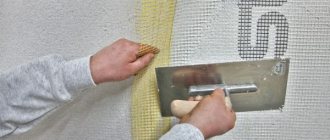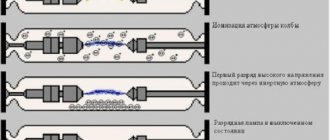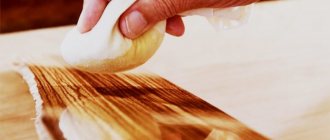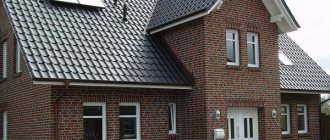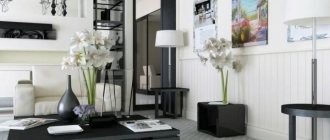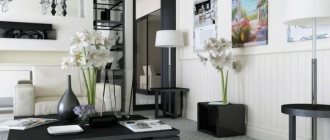Glass blocks are now used not only for partitions in the bathroom - they are used to zone any rooms, even creating building facades from them. They are also used as decorative elements in bulkheads made of other materials - plasterboard, wood, brick. Light transmission, heat protection, moisture resistance and external beauty are the main advantages of glass blocks.
They transmit light almost as well as ordinary glass, but are much stronger. To create a glass block wall, it is not necessary to hire specialists - if you know the technological nuances, you can do it yourself.
Types of glass blocks
The blocks are made by combining glass tiles about 7 mm thick into a kind of brick. There is rarefied air inside, thanks to which the block walls provide good protection from extraneous noise and conserve heat.
To create a beautiful partition, you need to know the sizes of glass blocks:
| Thickness | Weight | Dimensions | |
| Standard blocks | Half blocks | ||
| 7.5–10 cm | 2.5–4.3 kg | 19x19x8 cm or 24x24x8 cm | 19x9x8 cm or 24x11.5x8 cm |
Glass blocks for creating partitions do not necessarily look like bricks. To build extravagant bulkheads, pyramids, cubes, hemispheres, stars, corners, and curved products are used. The latter are more often used as decorative inserts.
The surface of glass blocks for bulkheads can be completely transparent, matte, colored, or corrugated.
Smooth, unpainted products can transmit up to 80 percent of light rays, tinted ones - up to 50 percent. Matte blocks diffuse light, while corrugated ones transform it, creating an interesting play of glare.
They also produce decorative bricks with pictures or even figures of animals, insects, shells, and ship models inserted inside. Modern technologies make it possible to equip the cavity of the block with LEDs, which creates a fascinating illumination of the partition.
What do you need to know before starting work?
1. The surfaces to which the glass block wall or partition will be adjacent must be prepared (at the junction). Namely, clean off the old finish, wash, let dry, and prime.
2. Glass blocks are usually sold covered with a protective film. It is not recommended to remove the film before installation is complete to avoid damage to the surface of the blocks, scratches, stains from glue and cement, etc.
If the blocks were sold without film, you can protect them yourself - for example, by covering the front surfaces of the blocks with masking tape.
Glass block laying technology
A glass block partition is a beautiful design and easy to construct. One person can handle its creation. Here it is important to know and follow the rules for installing glass block partitions in accordance with the chosen method - “wet” or “dry”.
Correct laying of glass blocks
To correctly lay glass bricks, you need to take into account the nuances of working with the material:
- The surface on which you plan to lay glass blocks must be completely flat and clean.
- The wall area should not be more than 15 square meters, otherwise the elements of the lower rows may crack due to significant load.
- A wall made of this material cannot be used as a load-bearing wall.
- The film protecting the glass blocks is removed only after the seams have been rubbed.
If you decide to use glass blocks to create partitions in the bathroom, it is better to use them to enclose the location of the old font, where all communications are already connected.
The base for a false wall must have a margin of load-bearing strength. If in doubt, reinforcements will need to be made using special metal structures.
Cement method of laying glass blocks
It is believed that creating a partition or ledge from glass blocks by laying them on a cement-sand mortar is the most economical. This process is called “wet”: it resembles bricklaying, only the glass blocks are not installed in a checkerboard pattern, but one above the other. Only a finely dispersed mixture can be used for the solution. Large fragments can damage the glass surface.
Using special glue will make the work even easier. Some compositions are produced colorless, which will preserve the ideal transparency of the false wall.
Identical seams between glass blocks are obtained using spacer crosses. If the bulkhead has a rounded configuration, then the crosses between the elements are installed only in the inner part of the rounding. On the outside, the seams will remain equal to each other, but will be larger than on the inside. Their size is affected by the rounding radius. The size of the joints in a rounded wall can be reduced by using “half” glass blocks. And the smaller the radius, the higher the need to use half-blocks.
To construct solid bulkheads of significant dimensions, it is necessary to assemble a frame base made of metal profiles, fixed to the floor, ceiling, or wall.
How to build a partition using the “wet method”:
- Mix a small amount of adhesive, enough to install three rows of glass blocks.
- Apply glue to all sides of the products. Between them, after installation, insert masonry crosses.
- After completing each row, lay reinforcing rods with a diameter of 4–6 mm on top. In the first row, also install them in the seams between the blocks so that they protrude above the masonry. This way they will fit into the seams of subsequent rows.
- Wait a day for the adhesive to completely harden.
- Repeat the cycles until the entire height of the partition is erected.
After the false wall is erected, the seams are rubbed down and the protective film is removed from the glass blocks. To close the connection between the partition element and the floor, a plastic plinth is used.
The use of this method is recommended for the construction of low bulkheads due to the fact that the first rows of blocks during the construction of high structures may crack.
Traditional method of laying glass blocks
In this case, the “dry” method of fastening glass blocks is used. They are fixed on special modular systems. This method allows you to quickly build completely smooth walls without using a plumb line or level.
The frame material is varied. These are plastic, wood, polyurethane, aluminum of various shades and textures.
Modular systems do not spoil the aesthetic appearance of the partition; on the contrary, they add an additional artistic effect to the design of the living room or bedroom.
Frame cells are made according to the size of glass blocks. During the work, constant checking of horizontal and vertical levels is not required, and the laying process progresses much faster.
The frame base is fixed to the wall, floor and ceiling using dowel nails or self-tapping screws. The blocks are fixed in the cells by using special rubber gaskets - seals or silicone sealants. The latter are used more often: the structure is stronger, since the blocks are glued into the frame. But when using rubber seals, the damaged element is easier to replace.
Installation is quite quick and can be completed even by an inexperienced builder. The advantages of this method are that the partition element can be moved if necessary.
Laying glass blocks with your own hands
If you decide to install a rectilinear volumetric partition made of glass blocks in the living room, hallway or bathroom, it is better to choose the “dry” method.
When designing a partition with a complex configuration, the cement method is chosen. The reinforcement bars will need to be bent to the desired shape.
For “wet” technology you will need:
- level;
- marker for marking;
- roulette;
- spacer crosses;
- wire cutters;
- drill:
- putty knife;
- tile drills.
You will also need a cement-sand mixture or glue, a container and a whisk for mixing, wire or fiberglass reinforcement.
A different set of tools and materials for creating a partition using “dry” technology with your own hands, for example, here you need a hammer drill, an angle grinder with a stone disc, seals or silicone sealant. If the module is wooden, you will additionally need a hacksaw with fine teeth and a screwdriver.
Before constructing the bulkhead, decide on its dimensions. They must correspond to the dimensions of the selected glass blocks - these elements cannot be filed. If there are discrepancies, it is better to purchase additional half-blocks of a suitable color.
In order not to make a mistake with the size and design, lay out the blocks in the desired order on the floor and draw a diagram indicating all sizes. Then make markings on the load-bearing surfaces, checking that the lines are vertical. After this, you can begin constructing the partition using the chosen method.
Removing tint
It may well happen that after tinting you decide that there is no need for it, and the glue for it is usually so strong that you just can’t get rid of it. The film is applied to glass in several stages, so it must be removed in the same way. After you remove it, the problem will arise how to wash off the glue from it. The most affordable option is to use soapy water. However, it does not always help, so when deciding how to remove the adhesive from the film, you can use commercially available compounds: a special spray or a rust converter.
Glass blocks in the interior of the apartment
The possibilities for using glass blocks for partitions in the interior are extensive. With their help, they decorate interior false walls of various shapes, enclose bathtubs and showers, create windows, columns and arches, and design flights of stairs.
Glass blocks will enliven and improve the interior design, decorated in a laconic style:
- minimalist;
- high tech;
- constructivist;
- pop Art;
- urban;
- eclectic;
- environmentally friendly;
- modern and postmodern;
- Art Deco.
But it is quite difficult to fit them into the classical, baroque or renaissance style, although it is possible as rare decorative elements.
Glass blocks successfully zone space: they can be used to separate the kitchen and recreation area in a studio apartment or to delimit the living room and hallway. Illuminated options look interesting, for example, a bar counter glowing from the inside or a decorative window made of colored glass blocks in the partition separating the sleeping area. And the most daring experimenters insert decorative elements into floor coverings.
A little safety
Modern glass blocks are of good quality. But they also have flaws. There are sharp burrs and sharp edges, so immediately get used to working with gloves.
Ordinary cloth ones are uncomfortable, even those covered with “pimples”. The glass block tends to slip out, and your hands get tired quickly.
It is best to use glazier gloves. On the palm side they are covered with latex, which does not slide on the glass as easily and better protects your fingers from cuts.
When working with an angle grinder, especially if you have to sharpen the edges of the block, be sure to use safety glasses and a respirator. Glass dust is an extremely harmful and insidious thing.
With this, let me take my leave.
We hope that beautiful and practical partitions made of glass blocks will make your home more convenient, more environmentally friendly, and give it a unique charm. Leave your tips and comments below. Subscribe to our newsletter. Good luck to you and good luck to your family!
Advantages and disadvantages of glass blocks
Transparent blocks let in enough light to eliminate the need for main lighting and save on electricity. But even colored products, due to their translucency, do not create the feeling of an enclosed space.
Other advantages of the material are:
- Non-flammability. The blocks hold high temperature for at least an hour.
- Good sound insulation and heat retention due to internal cavities. Due to this, blocks are used to decorate building facades.
- Resistant to odor absorption.
- Environmentally friendly and safe for health.
- Moisture resistance combined with the impossibility of mold and mildew formation.
- Low maintenance requirements. Such partitions can be cleaned with ordinary household cleaners for glass surfaces.
- Variety of decorative possibilities.
However, glass block partitions also have certain disadvantages.
You cannot hang a shelf or cabinet on them, since it is prohibited to make holes in the blocks. It is also impossible to hide communication highways behind them or inside them. If the window in the room is decorated with glass blocks, you will need to install a ventilation system - after all, it will not be possible to make a window. Also, the disadvantages of glass blocks include the high cost of quality products. Glass block bulkheads require precision in measurements and careful installation. But beauty and functionality more than pay for the efforts to create them.
Materials and tools (per 1 m2 of construction)
Materials (seam – 10 mm):
- Glass blocks 190×190×80 mm – 25 pcs.
- Glass blocks 190×90×80 – 50 pcs.
- Glass blocks 240×240×80 mm – 16 pcs.
- Glue (for glass blocks or ceramic tiles) – 25 kg.
- Mounting crosses – 36 pcs.
- Stainless steel fittings with a diameter of 6-8 mm – 6-8 m.
- Joint expansion joints (cork, felt, bitumen or PVC tape) - 1-4 m, depending on the presence of abutment to structures.
- Trowel (for applying the solution).
- Level and plumb line (to check the horizontality and verticality of the structures being built and adjacent to it).
- Wooden slats (for setting the boundaries of the partition on the base).
- Rubber hammer (for leveling blocks).
- Knife, grout, sponge (for cutting off protruding parts of crosses, making seams, cleaning the surface).
The surface of the base is cleaned of dust and grease and two wooden slats are placed on it to fix the direction of laying the blocks.
